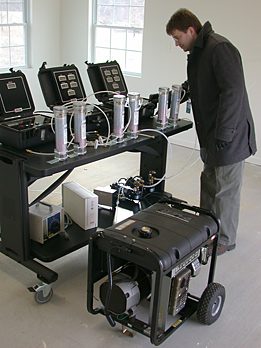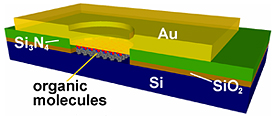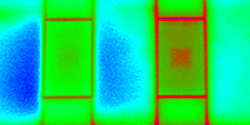| March 5, 2008

[NIST Tech Beat Search] [Credits] [NIST Tech Beat Archives] [Media Contacts] [Subscription Information]

NIST to Study Hazards of Portable Gasoline-Powered Generators
 |
NIST is working with the Consumer Product Safety Commission (CPSC) to quantify the dangers of improperly used gasoline-powered portable generators and to evaluate possible technical solutions to the problem. Here, NIST researcher Steven Emmerich adjusts a multi-gas analyzer that will measure carbon monoxide, oxygen, carbon dioxide and hydrocarbons concentrations produced by such a generator located, against safety advice, in a garage.
Credit: NIST
View hi-resolution image |
The same gasoline-powered portable generators that keep the lights burning, the freezer cold, and the house warm when a storm shuts off the electricity, can also kill you in minutes if you fail to follow safe practices. A single generator can emit several hundred times more poisonous carbon monoxide than a modern car’s exhaust. To help quantify the dangers of improperly used portable generators, and evaluate possible technical solutions to the problem, the Consumer Product Safety Commission (CPSC) has enlisted the National Institute of Standards and Technology (NIST).
The CPSC recently mandated explicit labels warning consumers of the danger of carbon monoxide poisoning associated with operating a portable generator in or near a home. While observing that generators are useful in emergencies, the commission warns consumers not to use a generator inside homes, garages, crawlspaces, sheds or similar areas, even when using fans or opening doors and windows for ventilation. Deadly levels of odorless and invisible carbon monoxide can quickly build up in those areas and can linger for hours, even after the generator has shut off, according to the commission, which received reports that at least 65 people died from carbon monoxide poisoning associated with portable generators in 2006. It can even be deadly to use a generator outside if its exhaust stream is too close to a home’s open doors, windows or air vents.
To learn more about the consequences of operating a gasoline-powered portable generator in the attached garage of a home, NIST researchers will collect data that quantifies carbon monoxide infiltration into a sensor-equipped house during different weather and house conditions. They will look at effects of variable outdoor temperatures and wind speeds, as well as different garage door positions and the influence of indoor HVAC systems. They then will attempt to duplicate experimental results with a model of the house created in CONTAM, NIST’s indoor air quality modeling software. A computer model, validated by test data, will allow NIST and CPSC staff to predict generator-related carbon monoxide concentrations and oxygen depletion rates that could be found in various types of homes under a broad range of conditions. Manufacturers, interested in technologies to modify gasoline-powered generators to address this hazard, should also find the emission information useful. NIST expects to report to CPSC on its study in Summer 2009.
Media Contact: John Blair, john.blair@nist.gov, (301) 975-4261 

Failure Investigations Report Highlights Efforts for Safer Buildings
The National Institute of Standards and Technology (NIST) has submitted to Congress the annual report of activities under the National Construction Safety Team (NCST) Act, which authorizes the agency to conduct technical investigations of major building failures in the United States. Although NIST did not conduct any new investigations of structural failures during the past year, the 2007 NCST report details significant progress in both the private and public sectors acting upon NIST’s previous investigation-driven recommendations for improvement in building and fire standards, codes and practices.
Those recommendations stem from NIST’s investigations into the failure of the two World Trade Center (WTC) towers following the terrorist attacks of Sept. 11, 2001, and The Station nightclub fire in Rhode Island on Feb. 20, 2003, that killed 100 persons. NIST expects this summer to complete its investigation of the failure of WTC 7, the 47-story office building that also collapsed on 9/11.
The report highlights a discussion of the first comprehensive set of building code changes based on the NIST WTC investigation that were approved by the International Code Council (ICC) in 2007 and were incorporated into last year’s supplement to the ICC’s International Building Code (IBC), a model code used as the basis for building regulations promulgated and enforced by U.S. state and local jurisdictions. Those jurisdictions have the option of incorporating some or all of the code’s provisions but generally adopt most of them.
The report also details the 47 proposals for code changes based on WTC investigation recommendations submitted to the ICC last August. These proposals address areas such as structural collapse, wind tunnel testing, emergency responder communications, sprinkler redundancy and sprayed-on fire resistive materials. All 47 items will be considered initially during this month’s ICC Code Development Hearings for potential forwarding to the ICC Final Action Hearing in September. Code changes approved at that time will appear in the 2009 edition of the IBC.
NIST investigations under the NCST Act, signed into law in October 2002, are designed to establish the likely technical causes of the building failure and evaluate the technical aspects of emergency response and evacuation procedures in the wake of such failures. The goal is to recommend improvements to the way in which buildings are designed, constructed, maintained and used. The 2007 NCST report to Congress is available on the NCST Web site, www.nist.gov/ncst.
Media Contact: Michael E. Newman, michael.newman@nist.gov, (301) 975-3025 

NIST Requests Comments on Proposed Biometrics Lab Program
The National Institute of Standards and Technology (NIST) is seeking public comments on a proposed new program to accredit testing laboratories that evaluate biometrics-based identification systems. The proposed Biometrics Laboratory Accreditation Program, requested by the Department of Homeland Security, would assess the ability of candidate laboratories to evaluate biometric technologies such as facial, fingerprint, retinal and voice recognitions against recognized national and international standards.
Governments and companies are increasingly relying on biometrics to recognize individuals. They will soon be used to identify all U.S. government and contract employees, and may replace personal identification numbers at banks and passwords for computing to minimize identity theft.
NIST published a notice* in the Feb. 29 Federal Register requesting comments on establishing an accreditation program for laboratories that perform biometric testing using recognized national and international standards under the National Voluntary Laboratory Accreditation Program (NVLAP).
NVLAP accreditation programs are established to provide unbiased, third-party validation of the technical competence of testing and calibration laboratories. The programs are created for specific fields in response to requests from Congress, other federal agencies or the private sector. NVLAP accreditation shows that a laboratory has demonstrated that it meets the program’s challenging management and technical requirements.
More information about NVLAP is available at www.nist.gov/nvlap. If you have questions or comments about the proposed biometrics NVLAP, contact Brad Moore, NIST/NVLAP program manager at (301) 975-5740 or at brad.moore@nist.gov.
* Docket No.: 080122071-8073-01. “Notice and Request for Comments on Proposed Establishment of a Laboratory Accreditation Program for Laboratories Performing Interoperability, Performance, and Conformance Biometrics Testing Under the National Voluntary Laboratory Accreditation Program.” Federal Register V. 73, Num. 41, Feb. 29, 2008, p. 11093.
Media Contact: Evelyn Brown, evelyn.brown@nist.gov, (301) 975-5661 

Good Vibrations Probe Innards of Molecular Electronic Junctions
 |
NIST researchers determined that the organic molecules in the middle of this simple silicon-based molecular “sandwich” pass electric current through these junctions by carefully measuring the minute changes in molecular vibrations.
Credit: NIST
View hi-resolution image |
Using an unusual spectroscopic technique, researchers at the National Institute of Standards and Technology (NIST) have provided the most convincing evidence yet that current is flowing through a simple silicon-based molecular “sandwich,” which is the most basic structure of molecular electronics. The work* is an important step toward realizing the dream of organic molecule-based electronics that could enable much denser, cheaper computer memories and other replacements of traditional electronic devices.
“The ultimate in miniaturization is the molecule,” explains NIST’s Curt Richter. “The hope is that a single molecule will one day be able to act as an electrical component such as a diode or a resistor with the ultimate goal being shrinking computer chips.”
For the past few years, scientists have been building and testing structures made of a hybrid of traditional silicon-based components and more futuristic molecule-based components. The typical junction is a sandwich of a metallic contact layer, a layer of organic compound just a single molecule thick arranged like bristles on a brush, and a substrate of silicon. Richter says that while the electric current seems to pass through the molecules, the current could be finding a way around it or the molecules could have been damaged in fabrication. Scientists want to know what is really happening inside this “black box.”
NIST researchers tried a little-used technique called inelastic electron tunneling spectroscopy (IETS) that measures the vibrations of the molecules inside the junction. “Each molecule has its own vibrational fingerprint,” says Wenyong Wang, adding “IETS acts as our eyes to see what is inside the black box.” An earlier paper by Wang and his colleagues at Yale University set IETS as a standard technique to prove that molecules remain intact in metal-based molecular electronic devices.
Colleagues at Purdue University provided three types of silicon-molecule-metal junctions that are a few micrometers large. The small molecules researchers used were octadecane, nitrobenzene and diethylaminobenzene.
Each silicon-molecule-metal device was cooled to cryogenic temperatures. Wang carefully measured the minute changes in the current passing through the junctions, and these current changes were then related to specific molecular vibrations. Thus, the researchers verified the existence of the molecules and that the electric current passed through them.
NIST physicists plan to continue research into silicon-molecule-metal junctions. “Once we understand the physics of the devices, we can begin to assess how viable the technology is and also determine which molecules may supply the best chance for a technological breakthrough,” says Richter.
* W. Wang, A. Scott, N. Gergel-Hackett, C.A. Hacker, D.B. Janes and C.A. Richter. Probing molecules in integrated silicon-molecule-metal junctions by inelastic tunneling spectroscopy. ACS Nano Letters, 8, 478 (2008).
Media Contact: Evelyn Brown, evelyn.brown@nist.gov, (301) 975-5661 

Energy Upgrades Pay Off for Taxpayers and Feds
 |
Infrared image of the outside wall of the control and test rooms. The test room, on the left, has undergone modifications. Its image shows significantly more blue (a colder temperature, less heat loss). The unmodified control room on the right shows little blue and much more green, orange and red colors that represent the warm air escaping to the outside.
Credit: NIST
View hi-resolution image |
Buildings account for 40 percent of the energy consumed within the United States and a similar percentage of carbon dioxide emissions. National Institute of Standards and Technology (NIST) engineers recently took a look at energy-related upgrades to their own quarters—and found energy-related improvements were well worth the expense. A NIST plan to act on the findings should save taxpayers money while helping meet a presidential order for federal agencies to cut energy consumption to 70 percent of 2003 levels by 2015.
The NIST researchers undertook their study using two adjacent offices in one of the general purpose buildings on the NIST campus. The building is typical of those constructed on the NIST campus in the early to mid-1960s. One of the two offices served as the control office and the second office was modified to reduce the flow of energy through the exterior wall. Each room was carefully instrumented to determine energy savings that could be realized through various energy savings options while maintaining identical levels of comfort.
The unmodified control office has a single-pane glass window unit and an antiquated heating and cooling unit. Thermal insulation was not present between the exterior walls of the office and the interior space. Significant air leakage occurred between the interior of the office and the outdoor air as a result of numerous gaps and voids in the exterior wall.
In the modified office all air leaks were sealed The exterior walls were insulated with approximately 9 inches of glass-fiber insulation and the more than 40-year-old single-pane glass window was replaced with a double-pane, argon-filled insulated glass window unit. A forced air heating and cooling unit was installed in the attic to deliver conditioned air to the office module, replacing the antiquated heating and cooling system that required piping in the office module walls. Energy upgrade expenditures came to approximately $2,825.
Measurements made to compare the energy required to maintain the control and modified office modules at identical conditions revealed a 59 percent savings. Annual cost savings from the energy upgrades, based on 2007 energy prices, came to approximately $195 per year. The researchers used NIST’s Cost Effectiveness Tool for Capital Asset Protection software to figure in a three percent annual energy price escalation rate. They found that over a 25-year period the improvements would generate an average $1.75 for each dollar invested.
NIST will begin implementing the research findings in April. In the first phase 22 offices will be upgraded with the energy savings features. The remaining 85 offices will be modified in 2009 and 2010.
Further information on NIST work to improve building energy efficiency can be found at NIST’s Building Environment Division Web site, www.bfrl.nist.gov/863/. NIST ’s Cost Effectiveness Tool for Capital Asset Protection Version 3.0 is available for download at http://www2.bfrl.nist.gov/software/CET/
Media Contact: John Blair, john.blair@nist.gov, (301) 975-4261 

Quick Links
NIST Mini Sensor May ‘Change the Way We Live’
Miniature magnetic sensors made at the National Institute of Standards and Technology (NIST) have won a spot on Technology Review’s annual list of 10 technologies “most likely to change the way we live.”
The atomic magnetometers, made by NIST physicist John Kitching and collaborators, are about the size of a grain of rice and require little power but are highly sensitive to very weak magnetic fields. Technology Review points out that tiny, inexpensive magnetometers could lead to portable magnetic resonance imaging (MRI) machines and tools for detecting buried explosives or evaluating mineral deposits remotely. The magazine also notes NIST’s miniaturization of magnetic sensors could greatly expand their use in the coming decade.
Read the whole story at “TR10: Atomic Magnetometers—John Kitching’s tiny magnetic-field sensors will take MRI where it’s never gone before”. Recent NIST news releases on the mini sensor technology are available at “New NIST Mini-Sensor May Have Biomedical and Security Applications” and “‘NMR on a Chip’ Features NIST Magnetic Mini-Sensor”. 
NIST/TRC Thermodynamic Tables Go Online
A popular chemical database distributed in printed form for 65 years by the National Institute of Standards and Technology (NIST) is now available online.
The NIST/TRC Thermodynamic Tables, distributed on a subscription basis through the NIST Standard Reference Data E-Commerce System, are available in two Web-based editions: professional and “lite.” The tables are reliable sources of critically evaluated thermophysical and thermochemical property data for pure, primarily organic, compounds. Researchers in government, academia, and industry can use the professional edition to find critically evaluated information about more than 50 thermophysical and thermochemical properties of 7,765 compounds. Annual license fees range from $1,200 to $2,500. The lite edition covers 150 commonly used compounds and annual license fees range from $200 to $1,500.
For further details or to purchase the full Web version, the NIST/TRC Web ThermoTables, Professional Edition (NIST Standard Subscription Database 3), see www.nist.gov/srd/nistwebsub3.htm. For the lite edition (NIST Standard Subscription Database 2), see www.nist.gov/srd/nistwebsub2.htm. 
NIST Web Site Features Waldseemüller Map Video
Visitors to the National Institute of Standards and Technology (NIST) Web site can view a video that portrays NIST’s construction of an encasement for the1507 Waldseemüller Map, often called “America’s birth certificate” because it is the first map to label the lands of the New World as “America.” The three-minute video tells viewers of the explorer Amerigo Vespucci (America’s namesake) and of the map’s purchase by the Library of Congress. NIST’s design, manufacture, shipment and assembly of the encasement, base, frame and display structure as well as their match up with the historic map are featured. Library of Congress and NIST officials also comment on the importance of the map to the nation. The Waldseemüller map is now on permanent exhibition in the Library of Congress in Washington, D.C.
To view the video, see “National Institute of Standards and Technology Helps Preserve the 500-year-old Waldseemüller Map”. For more on the NIST Waldseemüller encasement project see “NIST Encasement Now Protecting ‘America’s Birth Certificate’” 
April Tech Transfer Workshop Focuses on Nanotechnology Advances
Business executives, entrepreneurs, investors and government researchers and development officials interested in commercializing recent research advances in nanoelectronics, nanofabrication and nanometrology will meet April 8 at a Technology Transfer Showcase hosted by the National Institute of Standards and Technology (NIST) in Gaithersburg, Md. The day-long program is being sponsored by NIST, in conjunction with the Maryland Technology Development Corporation (TEDCO) and the Tech Council of Maryland (TCM).
NIST Acting Director James Turner will keynote the day’s events which will highlight nanotechnology innovations and describe ways to develop successful partnerships with NIST including licensing and Cooperative Research and Development Agreements (CRADAs). Poster sessions and tours of NIST nanotechnology facilities are also on the agenda.
Workshop speakers will cover a wide range of nanotechnology research topics ranging from characteristics of delivery systems for nanomedicine to single-molecule mass spectrometry, as well as the role of nanotechnology in building and construction and electronics.
The gathering is designed to offer ample networking opportunities for participants to meet with the workshop speakers and representatives from NIST nanotechnology facilities such as the Nanoscale Physics Laboratory, Center for Nanoscale Science and Technology (CNST), CNST Nanofab Shared-Use Facility, Magnetic Engineering Research Facility (MERF), the NIST Advanced Measurement Laboratory (AML) and NIST Combinatorial Methods Center (NCMC).
A full agenda and web registration for the technology transfer showcase can be found at www.nist.gov/partnerships. Registration closes April 1 for U.S. citizens and March 25 for non-U.S citizens. For more information contact Clara Asmail at (301) 975-2339 or via e-mail at clara.asmail@nist.gov.
|

